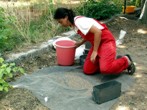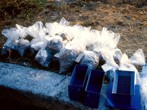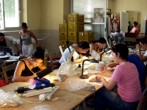|
|
| Palaeoenvironment |
 Archaeological research includes studies related to ancient environmental conditions (palaeoenvironment) and the investigation of the relationship between human groups and ecosystems. Plants constitute basic component elements of ecosystems. Given the sensitivity of plants to climatic changes, the study of the vegetation of the past allows the precise reconstruction of the palaeoclimate and of palaeoecological conditions. Furthermore, plants were and continue to be an object of use and transformation by humans as fuel and timber. As a result, research into vegetation provides a tool for the understanding of the role of humans in the shaping of the environment. Archaeological research includes studies related to ancient environmental conditions (palaeoenvironment) and the investigation of the relationship between human groups and ecosystems. Plants constitute basic component elements of ecosystems. Given the sensitivity of plants to climatic changes, the study of the vegetation of the past allows the precise reconstruction of the palaeoclimate and of palaeoecological conditions. Furthermore, plants were and continue to be an object of use and transformation by humans as fuel and timber. As a result, research into vegetation provides a tool for the understanding of the role of humans in the shaping of the environment. |
| |
| Methodology |
 Anthracology is the study of wood charcoal, which constitutes one of the most durable and abundant types of remains in archaeological excavations. The systematic collection of wood charcoal during the excavation is a necessary prerequisite for comprehensive study and analysis, since the different categories of material provide different sorts of information. Many samples of wood charcoal are the remains of fuel, while others derive from wooden objects or constructions that were presumably burned at some point in the past. The first category of material is the basis for the reconstruction of the vegetation of the past, while the second category provides information concerning the choice and use of wood for particular activities. Anthracology is the study of wood charcoal, which constitutes one of the most durable and abundant types of remains in archaeological excavations. The systematic collection of wood charcoal during the excavation is a necessary prerequisite for comprehensive study and analysis, since the different categories of material provide different sorts of information. Many samples of wood charcoal are the remains of fuel, while others derive from wooden objects or constructions that were presumably burned at some point in the past. The first category of material is the basis for the reconstruction of the vegetation of the past, while the second category provides information concerning the choice and use of wood for particular activities. |
| |
| Study |
During the excavation soil samples are taken from every excavation unit for study. The samples are cleaned by being wet-sieved so that even the smallest trace of wood charcoal, which floats, is gathered. Subsequently, the cleaned samples are dried and stored separately until they are studied under a microscope.  Thanks to the anatomical characteristics of plants, it is possible to identify the various plant genera and species. This is followed by the statistical processing of the data, by means of which information is drawn concerning vegetation and its use by human groups. Thus it is possible to reconstruct, to a certain extent, the environmental picture of the landscape surrounding the site during the Neolithic period. Thanks to the anatomical characteristics of plants, it is possible to identify the various plant genera and species. This is followed by the statistical processing of the data, by means of which information is drawn concerning vegetation and its use by human groups. Thus it is possible to reconstruct, to a certain extent, the environmental picture of the landscape surrounding the site during the Neolithic period. |
| |
Palaeoenvironment of the neolithic in
Northern Greece |
 The general picture we have from other Neolithic sites in Northern Greece for the time period we are interested in is characterised by the constant representation of Mediterranean deciduous forests without any major changes. The effect of human activities on vegetation seems to have been limited. The preliminary results of the anthracological analysis for Paliambela seem to confirm this picture. The general picture we have from other Neolithic sites in Northern Greece for the time period we are interested in is characterised by the constant representation of Mediterranean deciduous forests without any major changes. The effect of human activities on vegetation seems to have been limited. The preliminary results of the anthracological analysis for Paliambela seem to confirm this picture. |
|
|





